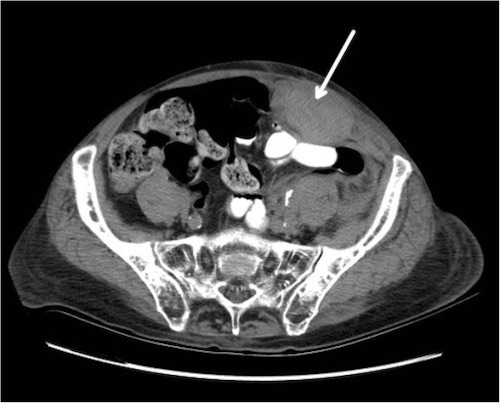Abdominal Wall: Rectus Sheath Hematoma
Rectus Sheath Hematoma
Basics
- Hematoma within the Rectus Sheath
- Most Common Cause: Injury to Epigastric Vessel Branches
- Most Are Spontaneous & Not from Trauma
- Risk Factors: Female/Elderly (Smaller Muscle) & Anticoagulation
Presentation
- Painful Abdominal Mass
- Fothergill’s Sign – Does Not Cross Midline & Does Not Change with Flexion
- Hernias are Generally More Painful/Prominent with Rectus Flexion
- Carnett’s Sign – Point of Maximal Tenderness Does Not Change from Supine to Sitting
Types Mn
- Type I – Small, Confined to Rectus, Does Not Cross Midline
- Type II – Confined to Rectus, Crosses Midline
- Dissects Along Transversalis Fascial Plane
- Type III – Large, Not Confined
- Usually Below Arcuate Line (Severe Bleeding – No Aponeurosis to Contain)
- Often See Blood in Prevesical Space of Retzius
Diagnosis
- Dx: CT or US
Treatment
- Stable: Observation
- Unstable or Enlarging: IR Angioembolization
- Surgery Indications:
- Skin Necrosis
- Unstable or Enlarging with Failure of Angioembolization
- *Remember to Reverse Anticoagulation as Needed
Surgery
- Procedure: Surgical Evacuation & Vessel Ligation
- Incision: Midline or Paramedian to Expose the Posterior Sheath (Avoid Entering the Peritoneum)
- Inferior Epigastric Artery Ligation:
- Incision: Oblique Over the Groin
- Carried Down to the Inguinal Ligament
- Inferior Epigastric Found Branching Off the Medial Aspect of the Distal External Oblique
- Rarely Required Only for Persistent Bleeding that Cannot Be Controlled
- Incision: Oblique Over the Groin

Rectus Sheath Hematoma on CT 1
Mnemonics
Types of Rectus Sheath Hematomas
- Type 1: 1 Side
- Type 2: 2 Sides
- Type 3: Past the Two Sides
References
- Sullivan LE, Wortham DC, Litton KM. Rectus sheath hematoma with low molecular weight heparin administration: a case series. BMC Res Notes. 2014 Sep 1;7:586. (License: CC BY-2.0)